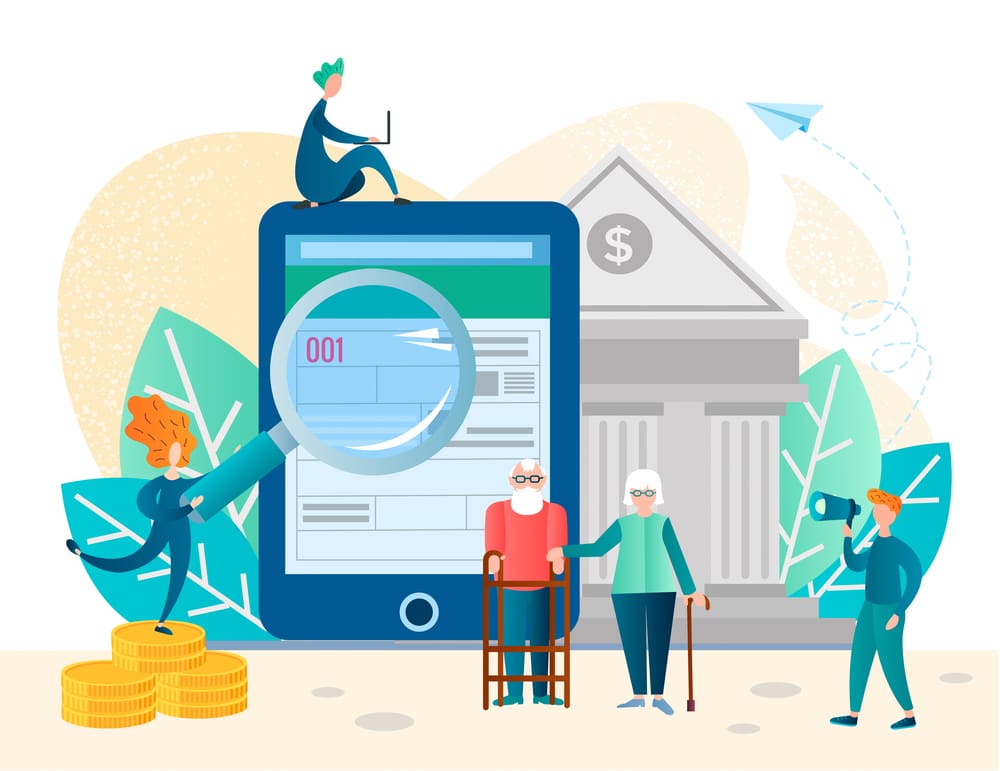Editorial Note: We earn a commission from partner links on Doughroller. Commissions do not affect our authors’ or editors’ opinions or evaluations. Learn more here.
I hate budgeting. I’ve tried using Quicken, YNAB, and even fancy spreadsheets. The results are always the same. I start strong, but within a few weeks, I lose interest in the time-consuming chore that budgeting can be.
The problem is that I still need to manage my money. So, what do I do?
I confronted this problem a few years ago and asked myself the following question
How do I effectively manage my money in as little time and with as little pain as possible?
To answer that question I came up with a money management plan that doesn’t require me to track all of my expenses every month and requires a relatively small investment of my time. In this post, I’ll share my plan on how to create a simple budget in under 10 minutes.
Before I get to the steps I take, it’s important to say that you should do what works best for you. You may need to track (or just feel more comfortable tracking) every dime you spend. That’s great if it works for you. You may also want to take my plan and modify it in ways to make it work better for your finances.
Either way, budgeting should be viewed as a means to an end. Budgeting and money management are a way to allow us to spend and save our money most productively and efficiently possible.
If you need 100 expense categories to accomplish that goal, so be it. If you can do it with just 5 expense categories, great! It turns out that I use just one expense category most of the time. Here’s how:
Getting Started: Know Your Expenses
This is one of the biggest obstacles to setting up a budget. You can’t create a budget without knowing how much money is coming in, how much is going out, and where it’s going. The only way to do this is by tracking your past spending habits, and that’s where the whole budgeting process can get tangled.
The best way to determine your expenses is the track them over at least the previous 12 months. The reason for tracking an entire year is so that you will account for all expenses incurred. It’s easy enough to track recurring expenses, like your house payment, debt payments, and fixed utility expenses. But along the way, there are variable expenses, like vacations and car repairs. To set up an accurate budget, you’ll need to account for all these expenses.
To get the most comprehensive picture of your expenses for the past 12 months, analyze the following accounts:
- All checking accounts used during the previous year, including and especially debit card activity.
- Any other accounts you spend money from, such as brokerage accounts that come with a debit card.
- Statements for any credit cards used during the year. Be sure to include any interest expense or other fees incurred.
- Cash expenses – these will of course be difficult to track, so you may need to make a reasonable estimate if they are common in your spending habits.
Analyzing your expenses will be a challenge if you have multiple spending accounts. But that analysis may also make you aware you may be using too many accounts. If so, one of your goals should be to reduce the number of spending accounts to maintain better control of your expenses.
Tracking Your Income
Don’t forget to tally your income as well. If all your income sources flow into your checking account it’ll be an easy job. But you’ll also need to include any payroll allocations going into savings, money markets, brokerage accounts, and especially retirement accounts. If funds deposited into these accounts usually stay there, it will provide you with an indication of how much you’re already saving.
Once you’ve calculated your income and expenses for the year, you can average them so that you can convert your finances to a monthly budget.
With your income and expenses for the past 12 months analyzed and categorized, you’ll know how much you have coming in, how much is going out, and what it’s going out for. That will put you in a position to make decisions about the future direction of your finances.
Save First
You’ve heard the expression, “Pay yourself first.” What this means is that you should first set aside a specific amount from each paycheck to be saved. Then, you can spend the rest. That’s what I do, and my budget looks like this (all percentages are based on gross income):
- Savings: 15%
- Spending: 85%
As long as I save 15% of my gross income and spend no more than 85%, I don’t typically care how much I spend on groceries or entertainment or electricity. Unfortunately, though, the fun can’t just stop there.
I have found at least three potentially significant problems with this simple approach.
- Failing to save as much as you comfortably can;
- Spending more than you planned to spend; and
- Getting whacked by periodic or unexpected expenses.
Recognizing these potential problems, I developed a simple approach to address each of them.

Update: My wife and I now save about 70% of our income. It helps that our mortgage is paid off and we live a modest lifestyle compared to our income. I’ve also switched to Empower’s free financial dashboard to manage everything from spending to our investments.
Let’s examine each of the three significant problems in more detail.
1. Failing to Save as Much as You Comfortably Can
How much money should you save? There’s no one right answer to that question. The goal is to achieve a reasonable balance between enjoying today and saving for tomorrow. For me that once meant saving between 10% and 20% of gross income. I view 10% as the absolute minimum goal and 20% as ideal for most individuals and families.
But what if I could comfortably save more? That’s one of the potential downsides to this simple budgeting plan. In and of itself, it doesn’t tell you how much you can reasonably and comfortably save.
To determine that number, I prepare a budget template. I use a simple Excel spreadsheet that divides my monthly expenses into three categories:
- Fixed expenses – mortgage, utilities, telephone, cable, etc.
- Variable expenses – groceries, entertainment, clothing), and
- Periodic expenses – car and life insurance, gifts, vacations, etc.
The fixed and periodic expenses are easy to determine by looking at past bills. If they fluctuate somewhat from month to month, use a 12-month average. The variable expenses can take some time to pull together; if you religiously use a credit card like we do, though, the information is right there in your bank statement. Once again, you can convert these expenses to a monthly amount by averaging them over the past 12 months.
With this information plugged into my spreadsheet, I can get an idea of how much (or how little) I can save. I can also see how making adjustments to my spending will increase or decrease my savings.
What I don’t do is track all of my expenses each month according to these categories. The template is there just as a guideline to determine how much I can reasonably save. If I’m not at 10%, I look for ways to trim expenses in one or more categories. I also look to see if I can reduce my expenses in some relatively painless way, to save even more.
You may be asking how I keep my expenses in check against this budget template if I don’t track all my expenses each month. Good question! That brings us to problem #2.
Another Budgeting Strategy: The 50-20-30 budget is a popular way to control your spending.
2. Spending More Than You Plan to Spend
So, you have a simple budget plan that calls for 10% savings, but you end up spending more than the 90% left over. This happens to all of us at times… but now what? Rather than going to the extreme and tracking every penny, I look at my expenses and determine what category (or categories) caused the most problems.
The problem expense areas are usually not a surprise to me. For us, it’s spending too much money eating out, buying too many clothes, or spending too much on the house.
I know these are our problem areas because I’ve been managing our money for 25 years. If you’re new to managing your money, it won’t take long for you to identify the two or three sticky areas in your budget. And here’s the point: track just those categories for a month. There’s no point in tracking expenses that aren’t causing the problem. Focus on the problem. You’ll spend a lot less time and you will direct your energy at the problem area(s) in your budget.
Learn More: Financial Freedom Calculator – How Much Should You Save?
Having tracked the problem areas for a month, you’ll have a better idea of why you’re spending more than you should. If it helps, put cash in an envelope for just these problem categories. When the cash is gone, you stop spending. Again, the point is to focus just on the problem areas of your monthly spending.
Related: Best Expense Tracker Apps
3. Getting Whacked by Periodic or Unexpected Expenses
It’s usually just when you think you’ve got control of your spending that the car insurance bill comes in the mail. In the past, this would drive me (no pun intended) crazy. Not anymore. For periodic expenses, I simply add them up over a year, divide by twelve, and put that much into my online savings account each month. When the bill comes in, I transfer the amount from savings to checking and pay the bill. For us, our periodic expenses include the following:
- Car Insurance (twice a year)
- Life insurance (once a year)
- Personal Property Tax (once a year)
- Gifts (throughout the year, but mainly at Christmas)
- Vacations (once a year)
For unexpected expenses, like a car repair, we use our emergency fund if we can’t include it in the monthly budget. Of course, we then have to add to our emergency fund, but that is what it’s there for.
Train Yourself: How to Keep One-Off Expenses from Breaking the Budget
As I said at the start, there is no one right way to budget. The best system to use is always the one that you will stick with.
For us, the simple approach is the best, and we’ve managed to control our spending quite well this way. Let us know what works for you if you use a different system!
Also Read: The Best Finance Apps for Every Budget
It is Possible to Create a Simple Budget in Under 10 Minutes?
If you’ve already analyzed your income and expenses it is possible to create a simple budget in under 10 minutes. The operative word is “simple”. You can make a budget as complicated as you like, but just keep in mind that the simpler a budget is, the easier it will be to follow.
That’s why I developed our budget as simply emphasizing a specific percentage going into savings. Once you set a savings target, and add it to your budget, you’ll have a goal each month. As long as you reach your savings goal, what you do with the rest of your money is much less important. What matters most is adjusting your spending to accommodate the savings goal. Once you do, your budget will accomplish its most important task – building your wealth.
Frequently Asked Questions (FAQ)
What is the 50-20-30 budgeting rule?
This has become a popular budget model in recent years because of its simplicity. You allocate 50% of your income toward necessary expenses, like housing, debt payments, and taxes; 30% is used for personal preferences, like vacations, gifts, and eating out. Finally, 20% is allocated toward savings. You can adjust the percentages to better fit your financial situation and preferences.
What are the five basic elements of a budget?
They’re basically what we covered in the article above. You’ll need to consider income, fixed expenses, debt payments, flexible expenses (groceries, utilities, and vacation expenses), and finally savings.
How do I start a budget with no money?
Surprisingly, how much money you have has less of an impact on your budget than you may think. The most basic factor of a budget is being able to live within your means, and that’s something that can and should be done whatever those means may be.
The process of starting a budget with no money is the same as it is if you already have money. The main difference will be in how aggressively you work to reduce spending. It may require cutting out most luxuries or even finding ways to cut back on necessities. That can include moving to a less expensive residence or buying a cheaper car.
Finally, your savings goals will be more basic. Rather than saving for investing, you’ll need to emphasize building an emergency fund. Once you do, you’ll be able to expand savings to accommodate investing and other financial goals.


